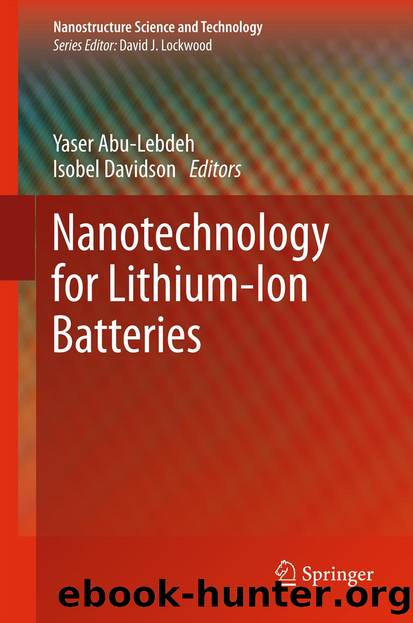Nanotechnology for Lithium-Ion Batteries by Yaser Abu-Lebdeh & Isobel Davidson

Author:Yaser Abu-Lebdeh & Isobel Davidson
Language: eng
Format: epub
Publisher: Springer US, Boston, MA
6.3.1 Graphene/Silicon-Based Materials
Silicon has been explored as anode material for lithium-ion batteries because of its high theoretical capacity (4,200 mAh g−1 or 9,805 mAh mL−1) and its natural abundance [46–48]. Silicon reacts with lithium via the following alloying/de-alloying reactions:
(6.1)
Up to 4.4, lithium can alloy with silicon leading to a maximum capacity of 4,200 mAh g−1. However, this large capacity is associated with a large volume change of 300–400% upon cycling [35, 49, 50]. The latter gives rise to mechanical stresses that lead to cracks, eventual disintegration of the electrode, and a failure of the battery [51]. All strategies to fix this problem have shown their limitations: use of nanoparticles, cellulose-based binder, composites, and nanostructures [37–41]. Graphene/silicon nanocomposite materials, where silicon nanoparticles are trapped between graphene sheets, might be a way to better mitigate the effect of the large volume change. Several research groups worked on making these nanocomposites using mixing procedures of either graphene or GO with commercial silicon nanoparticles. Table 6.2 summarizes the preparation procedure, ratio, and different capacity values of the composites prepared by different research groups around the world.Table 6.2Graphene/silicon nanocomposites preparation methods and capacity values
Download
This site does not store any files on its server. We only index and link to content provided by other sites. Please contact the content providers to delete copyright contents if any and email us, we'll remove relevant links or contents immediately.
| Automotive | Engineering |
| Transportation |
Whiskies Galore by Ian Buxton(40330)
Introduction to Aircraft Design (Cambridge Aerospace Series) by John P. Fielding(32338)
Small Unmanned Fixed-wing Aircraft Design by Andrew J. Keane Andras Sobester James P. Scanlan & András Sóbester & James P. Scanlan(32141)
Craft Beer for the Homebrewer by Michael Agnew(17446)
Turbulence by E. J. Noyes(7038)
The Complete Stick Figure Physics Tutorials by Allen Sarah(6638)
Kaplan MCAT General Chemistry Review by Kaplan(6053)
The Thirst by Nesbo Jo(5785)
Bad Blood by John Carreyrou(5768)
Learning SQL by Alan Beaulieu(5411)
Weapons of Math Destruction by Cathy O'Neil(5036)
Man-made Catastrophes and Risk Information Concealment by Dmitry Chernov & Didier Sornette(4735)
iGen by Jean M. Twenge(4702)
Digital Minimalism by Cal Newport;(4540)
Life 3.0: Being Human in the Age of Artificial Intelligence by Tegmark Max(4507)
Audition by Ryu Murakami(4098)
1,001 ASVAB Practice Questions For Dummies by Powers Rod(4038)
Electronic Devices & Circuits by Jacob Millman & Christos C. Halkias(4027)
Pale Blue Dot by Carl Sagan(4001)
